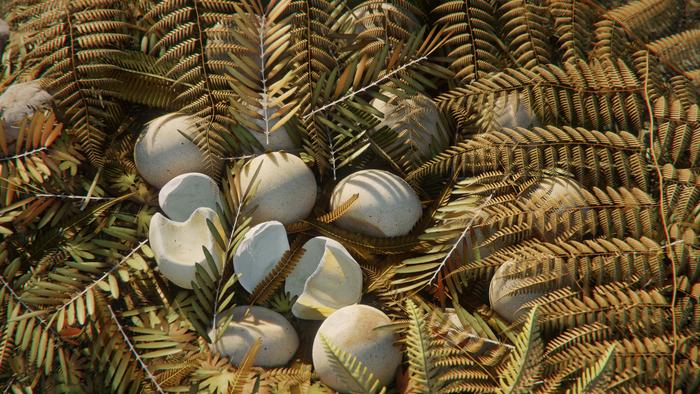A Stash of Leathery Dinosaur Eggs Tells Us About the Origins of the Giant Reptiles
Posted on Categories Discover Magazine

The discovery of a new dinosaur found within 10 feet of its fossilized eggs is shedding light on how early reptiles reproduced and the evolution of the egg.
Qianlong shouhu, which means “Guizhou dragon guarding,” lived during the early Jurassic Period some 190 million years ago, when it was an early precursor to immense sauropod dinosaurs such as the brontosaurus. Q. shouhu, however, was not so large and weighed a mere ton and measured about 20 feet long. Also unlike brontosaurus, it walked on its two hind legs, a stance probably not shared by its young.
Leftover Eggs From the Jurassic Period
The researchers from the Institute of Vertebrate Paleontology and Paleoanthropology (IVPP), part of the Chinese Academy of Sciences, learned a great deal about those young by CT scanning the egg fossils. By examining the curled-up skeletons, they concluded that Q. shouhu started out on all fours and at some point stood up and walked on just two.
The team found five egg clutches ranging in size from three to 16 eggs plus three Q. shouhu fossils a short distance away. The dinosaurs had probably covered the nest with plants or some other covering to protect the elliptical eggs, which were about five inches long.
The clutches are important finds because we still don’t know much about how dinosaurs reproduced, especially prior to the Cretaceous Period. We don’t know if the first dinosaurs eggs were leathery or hard-shelled, so the IVPP scientists attempted to determine the feel of the Q. shouhu eggs – in a fossilized state.
Read More: Dinosaurs Laid Eggs, So Do We Classify Them All As Reptiles?
The First Dinosaur Eggs
They noted that the shells were much thicker than a soft-shelled egg but also thinner than a hard-shelled one. Next, they looked at how the eggs had fractured as the scaly broken pattern provided more evidence for the egg’s material. The small-piece web was suggestive of a leathery egg. So were the rough surfaces of the eggs and their shape.
In all, it appeared that these eggs laid by early dinosaurs had once been leathery, a finding that likely extends to the first dinosaur eggs, the researchers said in a statement.
The team also built a massive family tree of reptile eggs (including Q. shouhu) to investigate the transition from dinosaurs to birds, which evolved during the time of the dinosaurs. They found that early in the evolution of the dinosaurs, egg size (relative to body size) tended to decline over the centuries, but then the metric made a turnaround. Early in the evolution of theropods – the meat-eating dinosaurs such as Tyrannosaurus rex – eggs increased in size again and continued the trend as birds evolved and began to lay relatively large eggs.
Read More: How Did Dinos Lay Eggs and What Were Dinosaur Eggs Like?